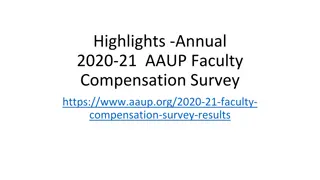Predicting Salary of Indian Engineering Graduates: A Data-Driven Approach
In India, a large number of engineering graduates struggle to find jobs in their core domain, leading to uncertainties in their salary prospects. This project aimed to predict the salary of Indian engineering graduates by analyzing various factors such as college grades, candidate skills, and market conditions. Through extensive data analysis, outlier detection, feature engineering, and trying out different regression models, the Random Forest technique emerged as the most accurate in predicting salary.
Download Presentation

Please find below an Image/Link to download the presentation.
The content on the website is provided AS IS for your information and personal use only. It may not be sold, licensed, or shared on other websites without obtaining consent from the author.If you encounter any issues during the download, it is possible that the publisher has removed the file from their server.
You are allowed to download the files provided on this website for personal or commercial use, subject to the condition that they are used lawfully. All files are the property of their respective owners.
The content on the website is provided AS IS for your information and personal use only. It may not be sold, licensed, or shared on other websites without obtaining consent from the author.
E N D
Presentation Transcript
ENGINEERING GRADUATE SALARY PREDICTION AKHIL D.U (IL022340) PGA-20
PROBLEM STATEMENT: Engineering Graduates in India: India has a total 6,214 Engineering and Technology Institutions in which around 2.9 million students are enrolled. Every year on an average 1.5 million students get their degree in engineering, but due to lack of skill required to perform technical jobs less than 20 percent get employment in their core domain. To determine the salary and the jobs these engineers are offered right after graduation. Various factors such as college grades, candidate skills, the proximity of the college to industrial hubs, the specialization one have, market conditions for specific industries determine this. Based on these various factors, The objective is to determine the salary of an engineering graduate in India. PROBLEM STATEMENT:
BUSINESS USE: The model will help to predict The Salary of An Indian Engineering Graduate Through various EDA analysis done, it allows to understand what influences the salary and job titles in the labor market. BUSINESS USE:
APPROACH: APPROACH: Note : RMSE & MAPE value has been used to Evaluate the best model. MAPE <10% for a model is considered as good model to be able to make accurate prediction. Hence the model with least MAPE value closer to 0 will be selected as the best model.
FINDINGS AND THE METHODS USED: Data was understood by performing various extrapolatory data analysis on the dataset for both Continuous and Categorical Features. Few Columns in the data frame had an invalid value as -1 , therefore converted them to null values and performed imputation using KNN imputer Specialization & CollegeState variables had too many categories in them resulting in High Cardinality. Hence, reduced by grouping the categories based on logic. Outliers were present for all the columns, performed the Outlier analysis via IQR method Data engineering was done on the DOB column to extract features like `year`, `quarter`, `weekofyear`, `month`, `day`, `hour`, `minute`. further converted the Column as Age variable by subtracting the values with current year Due to presence of Outliers, Performed Feature Scaling for all the numerical variables through Standardization Through the VIF checks, No multicollinearity exists for any of the columns and each variable was independent to each other FINDINGS AND THE METHODS USED:
Different Regression models were tried out such as Linear Regression both SGD & CFS, Decision Tree, Random forest & Random forest using best parameters, Boosting algorithms like Adaboost, GradientBoosting & XGBoost. Based on comparing the Evaluation metrics (RMSE & MAPE), Model built using Random Forest technique provided Least error compared to all other techniques.
COURSE ENROLLED BY STUDENTS COURSE ENROLLED BY STUDENTS Majority of the students almost 91.96% are B.Tech/B.E graduates by this we can conclude that most students in India have B.Tech as their Highest Education
CORE SPECIALIZATIONS STUDENTS CONSIDER FOR GRADUATION CORE SPECIALIZATIONS STUDENTS CONSIDER FOR GRADUATION Majority of the students have been enrolled in Computer Science & Engineering specialization or Computer related course like programming, networking, etc. Electronics & communications is next specialization after CSE, to which most of the students choose as their specialization.
FURTHER IMPROVEMENTS: Feature selection techniques such as forward elimination, backward elimination and RFE method can be used to select features for further improvements.
4 RESULT: RESULT: Out of all the models built using different Regression Techniques, Random Forest algorithm using feature selection technique yielded the best Evaluation result compared to other models. RMSE: 36030.17448662575 MAPE: 3.749811842532091























